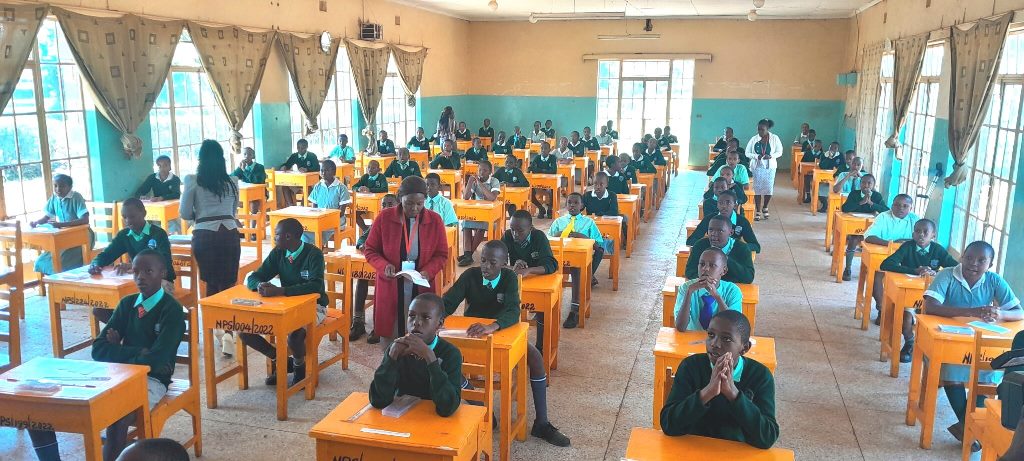The upcoming Kenya Junior School English Assessment (KJSEA) Paper 2 represents an important shift towards assessing learners’ understanding and creative engagement with literature and language in a holistic and learner-centred manner. The paper, carrying a total of 50 marks, will assess key components of the English curriculum: imaginative writing (15 marks), the novella (10 marks), the play (10 marks), oral literature (10 marks), and poetry (5 marks). Each section has been carefully designed to evaluate learners’ interpretive, analytical and expressive abilities, while nurturing creativity and moral development.
The imaginative writing section will be presented as a starter composition that learners will be required to complete. This task encourages learners to think creatively and extend an existing storyline in a logical, engaging, and coherent manner. It will test not only their command of language but also their ability to craft narratives with clear beginnings, climaxes, and resolutions. The emphasis on a positive story with a moral aligns with the competency-based curriculum’s vision of nurturing values and positive attitudes in learners. The story must therefore demonstrate moral integrity and social responsibility, reinforcing virtues such as honesty, empathy, hard work and resilience. By giving learners a partially written story, the test eliminates the intimidation of starting from scratch, allowing them to focus on creativity, continuity and coherence. The task will also assess the use of stylistic devices such as dialogue, suspense, flashback and vivid description, which enrich storytelling and engage readers.
The novella section will focus on setting, theme, characterisation and stylistic devices. This reflects the broader objective of helping learners to read, understand and analyse literary texts beyond mere comprehension. Setting helps learners appreciate the role of environment, time and context in shaping events and characters. Thematic analysis will test their ability to identify and discuss central issues or messages communicated by the author, such as friendship, courage, family or justice. Through characterisation, learners will demonstrate an understanding of how authors develop personalities, emotions, and conflicts to drive the story. Stylistic devices, such as symbolism, imagery, and contrast, will further test their sensitivity to language use and artistic expression. The inclusion of a novella at this level is crucial in developing analytical reading skills and preparing learners for more advanced literary studies in senior school.
The play section will similarly revolve around setting, theme, characterisation and stylistic devices but within the framework of drama. Learners will be expected to demonstrate an understanding of how a play’s setting influences mood and conflict, how characters’ actions reveal underlying themes and how dialogue and stage directions contribute to meaning. Plays offer learners the opportunity to experience literature in a performative and interactive form, helping them appreciate communication, teamwork, and empathy—skills vital in everyday life. Questions may also test understanding of conflict, dramatic irony and tone, as these are central to appreciating how playwrights use structure and language to entertain and instruct. The section aims to cultivate a love for theatre and performance, encouraging learners to express themselves confidently and appreciate drama as both an art form and a reflection of society.
READ ALSO:
Controller of Budget accused of frustrating release of county bursaries
The oral literature section will assess knowledge of key aspects, including stock phrases, their functions, moral lessons, features of oral literature, and the socio-economic activities reflected in oral texts. Stock phrases—such as traditional openings, repeated expressions, and closing formulae—serve important narrative functions: they establish rhythm, aid memory, and signal transitions in oral performance. Learners will be expected to identify such features and explain their significance. Questions on moral lessons will test comprehension of the values embedded in oral narratives, reinforcing the idea that storytelling in African traditions serves not just entertainment but education and moral instruction. The inclusion of socio-economic activities will test learners’ ability to link oral texts to the daily lives, occupations and social structures of the communities that produced them. This grounding in cultural context helps learners appreciate oral literature as a living heritage that shapes identity and social cohesion.
The poetry section, worth five marks, will be simple yet significant. It will test learners’ understanding of the poem’s structure, persona, message and stylistic features. Learners will need to identify who is speaking in the poem, what they are expressing and how the poet uses language to achieve effect. Questions may test your understanding of repetition, imagery, rhyme, rhythm, and symbolism—fundamental tools for interpreting poetry. The simplicity of this section ensures accessibility while laying the foundation for a more profound appreciation of poetic art in later stages. Poetry teaches learners sensitivity to language, emotion, and rhythm and encourages reflective thinking about human experiences.
Overall, the design of KJSEA English Paper 2 is both progressive and practical. It moves away from rote memorisation and embraces critical thinking, moral reflection and creativity. The integration of different literary genres ensures that learners experience language as a tool for communication, imagination and cultural understanding. By testing writing, reading, analysis, and interpretation in a balanced manner, the paper nurtures the learner’s capacity to think, feel, and express ideas effectively.
Moreover, the moral dimension embedded in the imaginative writing task and the analysis of literary texts aligns with the national goal of education—to develop learners who are not only knowledgeable but also ethical and empathetic citizens. Literature is uniquely positioned to cultivate these attributes because it mirrors human behaviour, choices and consequences. By engaging learners in stories, poems and plays that challenge their thinking and inspire positive values, the KJSEA framework strengthens the link between language education and character formation.
In essence, this paper is more than an examination; it is an assessment of creativity, moral awareness and literary competence. It rewards originality, clarity and insight rather than memorised facts. Through it, learners are guided to see literature not as an academic burden but as a mirror of life and a bridge to understanding others and themselves. The Kenya Junior School English Assessment Paper 2 thus stands as a significant milestone in nurturing a new generation of reflective readers, skilled communicators and responsible citizens.
By Ashford Kimani
Ashford teaches English and Literature in Gatundu North Sub-county and serves as Dean of Studies.
You can also follow our social media pages on Twitter: Education News KE and Facebook: Education News Newspaper for timely updates.
>>> Click here to stay up-to-date with trending regional stories
>>> Click here to read more informed opinions on the country’s education landscape
>>> Click here to stay ahead with the latest national news.






